New generation of photocatalytic self-cleaning systems for functionalization of technical textiles and architectural coatings – CLEANPHOTOCOAT
Home
Romanian National Authority for Scientific Research
CNDI–UEFISCDI, PN-II-PT-PCCA-2013-4
project number 0864
contract number 94 / 2014
Objectives
- Identification of suitable main and auxiliary compounds to be used for obtaining photocatalytic materials and coatings and establishing specifications;
- Designing, obtaining and characterizing the photocatalytic materials, sensitizers and film building materials;
- Conducting lab scale experiments to obtain photocatalytic materials and coating materials and execute prototype coating materials;
- Evaluating the performances of photocatalytic and coating materials on different supports;
- Overall coordination of the project and dissemination of the relevant project outcomes.
Estimated results
New products :
- Photocatalytic materials with high optical activity;
- Coating compositions containing photocatalysts for different substrates (technical textiles and construction structures).
Technologies for obtaining :
- Photocatalytic materials – experimental and functional models;
- Photocatalytic coatings for various types of textiles and construction structures-models and prototypes
Publications:
4 articles, 1 patent, 2 communications, 2 posters
Stages
Stage I – 2014
Defining requirements and specifications of photocatalytic coating materials intended for some flexible and rigid supports.
Stage II – 2015
Implementation of some phtocatalytic film building materials with high sensitivity in visibile light and evaluating their performances
Stage III – 2016
The realization and technology experimentation of photocatalytic coating systems at laboratory level.
Stage IV -2017
Pilot experimentation of obtaining technology of some photocatalytic film building materials for technical textiles and architectural coatings.
Partners





National Research and Development Institute for Chemistry and Petrochemistry – ICECHIM
Institute of Physical
Chemistry
“Ilie Murgulescu” Romanian Academy
National Research and
Development Institute for Materials Physics
National Research and
Development Institute for Lasers, Plasma and Radiation Physics
SC CHIMCOLOR SRL
About
Pollution and its side effects on health, structural damage of materials, costs for maintenance, cleaning and replacement of damaged materials is one of the most important causes of severe human diseases and of great economic losses all over the world. The project is focused on the development of new photocatalytic coating materials for technical textiles and architectural finishing systems that can be used to decompose pollutants in the air and on the coated surfaces in order to maintain a clean and healthy environment and avoid economic loses.
The objective of the project is to obtain stable, adherent, efficient and durable daylight photocatalytic self cleaning coatings for different types of substrates, such as flexible technical textiles and rigid construction structures. To accomplish the objective, issues that require skills in various fields are to be addressed, in view of: scientific research for designing new photocatalysts, innovation activity for the improvement of their efficiency by extending absorption in the visible range of the spectrum, and technological development in order to obtain photocatalytic coatings dedicated to a particular type of substrate. All these issues will be solved due to a multidisciplinary partnership formed of high rank specialists in materials physics, laser physics, physical-chemistry, polymer chemistry, dyestuffs chemistry, and chemistry of textile materials, constantly having in mind obtaining safety products and technologies and achieving economic advantages from the production stage up to the application by the end-users.
The method used for the synthesis of semiconductor materials is a key factor that determines their efficiency, the main reason for developing comparative studies regarding the most important oxide type photocatalysts used in practice (TiO2 and ZnO) that could be obtained and doped by wet methods (hydrothermal,sol-gel) or by laser pyrolysis route. Investigations developed in the project comprise also sensitizing the photocatalysts at the surface or by obtaining composites in order to use more efficient visible light in the photocatalytic decomposition of pollutants. Thus, we aim to develop new and optimized photocatalytic materials exhibiting activity upon visible light with surface characteristics of improved performance and of the high chemical and physical stability, crucial for broader scale utilization of photocatalytic systems in commercial application.
The photocatalytic coatings that will be obtained will be compatible with the substrates, protect them to self-degradation and maintain their initial
physical-mechanical characteristics, presenting high photocatalytic efficiency in visible light and durability. The newly developed photocatalytic coatings
during the project will decompose air pollutants and other contaminants in outdoor and indoor applications using sunlight or artificial light, especially
after expanding widespread use of LEDs for interior or exterior lighting of buildings, tunnels, advertising materials, thus making possible an enhancement
of the photocatalytic effect and thus providing significant benefits for the environment and human health.
Photocatalytic materials obtained in project together with the development of technically applicable photocatalytic coating systems adaptable to different types of substrates will represent a step change in this field particularly regarding the economic viability of a range of potential processes.
Project development
Stage I – 2014
Defining requirements and specifications of photocatalytic coating materials intended for some flexible and rigid supports
At this stage of the project the team of ICECHIM developed some activities related to the synthesis of some sensitizers of phthalocyanine type were carried out and all the proposed structures were validated by structural characterization. A study regarding structural type of sensitizers under investigation or as existing commercial products on the international markets was developed making correlations between necessary structural characteristics and properties of the photocatalytic materials which can be obtained using these materials. Studies revealed structural particularities for this type of compounds in order to harvest more photons and to obtain a high sensitivity of the semiconducting photocatalysts on a large spectral range. Such systems must meet several important requirements, namely: development of appropriate structures to allow fine tuning of optical, electronic and photophysical properties in the context of avoiding aggregation phenomena and maintaining sensitizer stability during operation over extended periods of time; achieving a significant overlap of the absorption spectra in the 400 nm region, which creates the premises of extending the photocatalytic activity in the visible range; to obtain an intense absorption band situated at long wavelength.
According to the study preliminary experiments on the synthesis of phthalocyanine derivatives such as Zn, Co, Al, Ti, Cu, Mn, Fe, Si and Ni
phthalocyanines at microwaves and their characterization were conducted. These compounds will continue to be used for the preparation of photocatalysts sensitized in the visible range which will serve as a reference in subsequent studies. We have also synthesized and characterized derivatives of Zn, Co, Ni and Cu phthalocyanines, peripheral substituted with carboxylic groups.
In this stage the team from the Institute of Physical Chemistry conducted a study on the structural types of photocatalysts and their
performance evaluation and on this basis were selected two structures of titanium dioxide doped with Fe and V, for which preliminary experiments
regarding synthesis, structural and morphological characterization were conducted. These materials were compared to the undoped titanium dioxide synthesized by the sol-gel method. Also, in the case of titanium dioxide undoped and doped with vanadium, photocatalytic activity was verified in the process of methanol photo-oxidation.
The team from the National Institute of Materials Physics developed a comprehensive study related to the definition of requirements and
specifications of photocatalytic materials used to obtain coatings for various substrates, emphasizing the most important semiconducting photocatalysts used in practice, namely titanium dioxide and zinc oxide, types of dopants used to extent of absorption in the visible domain and strategies for improving titanium dioxide photoactivity. Considerations about methods of improving photocatalytic activity of zinc oxide were made including the usage of TiO2 / ZnO tandem photocatalyst. As a conclusion of the study carried out it can be stated that although in the last 25 years have published over 13,000 ISI papers regarding TiO2-photocatalysis system and 1500 on ZnO system and the number of patents in the field worldwide, is also impressive, the problem is far from solved. Basically, there is not yet adopted a reference material and photocatalysts works only partially in the visible range and manifest a specific action only on certain pollutants, the way to identify new synthetic routes and doping treatments remains open in order to obtain photocatalysts with higher performances. It was also developed a comparative study regarding the performance of photocatalysts obtained by the solvo- / hydrothermal method, applications of the method and realization of functional modifications by doping TiO2 and ZnO by hydrothermal method.
The team from the National Institute of Laser Physics conducted activities on the identification, selection and characterization of oxide type
compounds with photocatalytic effect, focusing on laser pyrolysis as the main method to obtain powders. Preliminary experimental studies on the synthesis, characterization and checking of photocatalytic activity of undoped titanium dioxide and zinc oxide powders obtained by laser pyrolysis, highlights materials exhibiting structural and morphological properties necessary to further develop compounds with photocatalytic activity in the visible domain of the solar spectrum. Installation with vaporizer patented, made by the research team will allow the synthesis of suitable doped photocatalysts with controlled structure and morphology in order to improve the photocatalytic activity.
CHIMCOLOR performed activities related to the identification of structural types and methods of physico-chemical characterization of the
constituents necessary to achieve photocatalytic coating materials and to obtain and characterize coating matrices compatible with photocatalytic systems depending on their application on flexible or rigid supports.
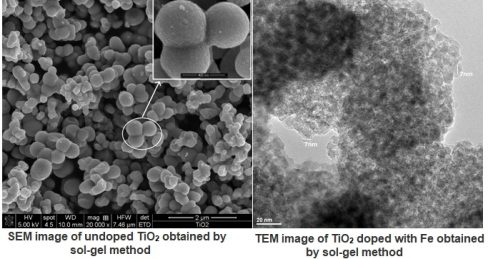
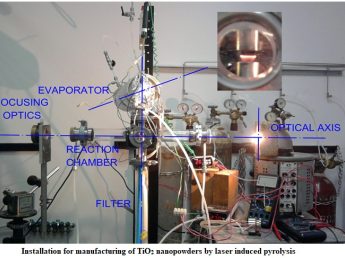
Stage II – 2015
Implementation of some phtocatalytic film building materials with high sensitivity in visibile light and evaluating their performances
At this stage of the project, ICECHIM carried out activities related to obtaining and characterization of sensitizers for making heterojunctions with photocatalytic semiconductors of oxide type (TiO2 and ZnO). Regarding photocatalytic composites with heterojunctions of type A were considered phthalocyanine dyes which have been synthesized in microwave field. Also, for the same purpose were selected basic dyes with high photochemical resistance. To achieve the photocatalytic composites with heterojunctions of type B was studied the synthesis of nanometric iron oxides, particularly goethite (α-FeOOH) which shows absorption in the area of interest (near the value of 400 nm). Composites obtained by hydro / solvo – thermal conditions were characterized by X-ray diffraction and electron microscopy, BET porosimetry, FTIR spectrometry and diffuse reflectance spectroscopy in visible domain, thermal analysis, and by conducting photocatalytic tests at artificial LED light, noticing the promising performance of selected composites, especially in indoor applications.
ICF developed activities regarding preparation of simple TiO2 and Vanadium-doped TiO2, but also pristine ZnO materials by sol-gel method. The obtained powders were characterized in order to clarify their structure, morphology, and thermal behavior and adsorption properties. The photocatalytic properties of the samples were also investigated. TiO2 powders have been obtained starting from Ti(OC2H5)4 as TiO2 precursor and from 0.5M solution of zinc acetate dehydrate in absolute ethanol in the case of ZnO. V doped TiO2 nanometric powders with molar ratios of TiO2:V2O5 of 98:2 and respectively, 99.95:0.05 were synthesized using sol-gel method, employing Ti(OC2H5)4 as TiO2 source and VO(Acac)2 as V2O5 source. A complex and systematic characterization of the the obtained gels and powders was extensively performed by different methods of analysis as: thermogravimetric and differential thermal analysis, X-ray diffraction, X-ray fluorescence, scanning electron microscopy, Fourier-transformed infrared spectroscopy, specific surface area and porosity measurements. It has been emphasized that the TiO2 samples containing
different amount of V did not show evident differences related to the structural properties, but this variation could be correlated with their
textural and catalytic properties. The undoped powders (TiO2 and ZnO) have been tested for the photocatalytic degradation of Rhodamine B, the initial concentration of RB solution was 10 mg/L. The evolution of the dye concentration was monitorized by the UV-VIS Spectrophotometry. The photocatalytic activity for tested oxide materials was evaluated by measuring the Rhodamine B conversion. The transformation of the Rodamine B after 30 minutes of irradiation was 55% for TiO2 and 54% for ZnO. These results show that TiO2 and ZnO samples could be successfully used in our future work also for organic compound photodegradation reactions or in photocatalytic systems related to self cleaning processes. The photocatalytic properties of the V-doped TiO2 nanopowders powders with different V content were investigated under solar light irradiation for water splitting and methanol oxidation. The obtained results pointed out that the Ti-V 0.05% catalyst shows better results for water splitting while Ti-V 2% catalyst is more active in methanol oxidation.
In agreement with the Activities scheduled in the Project’s Working Plan, the following items were accomplished by NIMP:
- Hydrothermal synthesis of TiO2 for photocatalytic applications using common row materials; preliminary experiments regarding RE doping (Eu, La, Nd) with the aim to shift the absorption toward the visible solar spectrum, have also been performed;
- Hydrothermal synthesis of ZnO at moderate temperatures and pressures (200°C, 14 at) for photocatalytic applications; preliminary synthesis regarding the metal transition (Fe) doping to increase the catalytic activity were performed.
- The obtained samples were characterized from the point of view structure (XRD) morphology (TEM-SEM), XPS, optical properties (UV-vis) and were tested as photocatalytic materials in both UV and Visible light.
- Hydrothermally synthesized TiO2 calcined at 400 °C exhibits a good but not amazing photocatalytic activity. The preliminary Eu doping
and Eu- Nitrogen codoping revealed a product with remarkable visible light activity, even higher than in UV light; this behavior support the studies
regarding the RE doping of TiO2 catalyst. A systematic study of the dependence of photocatalytic activity versus doping RE element in order to identify the optimum configuration for applications has to be done.
- Undoped and Fe (1-3% at.) doped ZnO were synthesized hydrothermally. The best behavior in visible light was found in the case of undoped ZnO. The finding agrees well with the literature but a rigorous explanation is still missing.
- The photocatalytic tests (not a task for us at this stage of the project) were performed on Methylene Blue by means of a Photocatalytic checker that can compare two samples at the same time. The behavior of these photocatalytic materials on other pollutants, in specialized photocatalytic reactors should of huge importance.
INFLPR partner developed activities in connection with the synthesis of photocatalytic TiO2 powder, designing more experimental laser pyrolysis devices, depending on the application. Compounds obtained by laser pyrolysis were characterized from the point of view of their structure and morphology, finding analogy with products sold on the market, especially with P25 which is considered a standard in this field. In order to
determine the photocatalytic effect, variations in the absorbance of a Methylene Blue solution was plotted against time during the action of TiO2 photocatalyst under UV irradiation (368nm), highlighting that the product obtained by laser pyrolysis is significantly better than P25 standard.
CHIMCOLOR carried out activities related to the establishment of component specifications for architectural coatings having photocatalytic effect and alternatives for obtaining of some film forming systems of photocatalytic type for architectural coatings, developed application tests on rigid substrates (concrete, stone, bricks), evaluated physical-chemical, mechanical and fastness properties of the coatings. Selection and characterization of coating systems was made depending on the scope and application domains on flexible or rigid substrates.
Stage III – 2016
The realization and technology experimentation of photocatalytic coating systems at laboratory level.
At this stage of the project, ICECHIM conducted tasks related to evaluation of photocatalytic properties of synthesized materials throughout the project and selection of the best performing products. Photocatalysts obtained by sensitizing Evonik P25 titanium dioxide with phthalocyanine dyes or iron oxides were tested after incorporation in a water-soluble styrene-acrylic film forming matrix. Although extraction tests by leaching of organic sensitizers lead to spectacular results, high stability within a pH range located conveniently at the optimum operating pH of the photocatalysts, there are a lot of problems about photodegradation resistance of sensitizers, particularly for those of organic nature. Regarding coatings designed for textile substrates study it was focused on obtaining organic-inorganic hybrid films – which can be applied by impregnation-thermofixation on hydrophilic or hydrophobic media. By variations in impregnating sol composition is ensured formation of adhesive and resistant films, compatible with textiles and sustaining photocatalytic effect of materials embedded therein.
ICF prepared doped TiO2 and ZnO based materials by sol-gel, eco-friendly method, which have been systematically investigated from structural, morphological, thermal and photo-catalytic point of view. Iron doped TiO2 samples were synthesized by sol gel method employing two different precursors for Ti (titanium tetraisopropoxide -TIP, titanium ethoxide -TEP) and Iron(III) nitrate nonahydrate as Fe source in concentrated alcoholic starting solutions. For the preparation of pristine ZnO, 0.5M solution of zinc acetate dihydrate in absolute ethanol was utilized. Modification of ZnO powder has been achieved by impregnating with 0.2 mM solution of HAuCl4·3H2O and further thermally treated at 500 oC for 3 hours in air stream. All materials have been characterized by complementary methods of analysis: DTA/TGA analysis, X-ray diffraction, X-ray fluorescence, scanning and transimission electron microscopies, Fourier-transformed infrared and UV-VIS spectroscopies, and specific surface area.
The photocatalytic properties of the iron doped TiO2 materials have been investigated under solar light irradiation (AM 1.5) for Metilen Blue fotodegradation as well as for the mineralization of the oxalic acid. The fotodegradation of the metilen blue showed a dye conversion of 50-60% after 3h of reaction for the Fe doped TiO2 catalysts. The study of the oxalic acid mineralization reaction has revealed the generation of H2 as minor reaction gaseous product in addition to significant amount of CO2 as main product, thus proving that the prepared TiO2-based catalysts could be used in photomineralization applications. On the other hand, related to the Rhodamine B fotodegradation in the presence of ZnO-based materials, it was observed that the Au-modified catalysts expressed an increased rate of dye photodegradation as compared to the pristine ZnO.
According to the activities scheduled in the Project’s Working Plan, NIMP achieved the following items:
- Synthesis by hydrothermal method and characterization of TiO2, codoped with nitrogen (N2) and rare earth ions, as: praseodymium (Pr3+), samarium (Sm3+), dysprosium (Dy3+) and ytterbium (Yb3+). Firstly, we prepared a precipitate precursor of TiO2 doped with one of the mentioned rare earths and then, the coprecipitated is doped in autoclave with nitrogen resulted from urea added to precipitate for this purpose.
- Synthesis by hydrothermal method of ZnO codoped with iron ions (Fe3+) and neodymium (Nd3+). We have prepared powders of ZnO doped with 2 at. % Fe and various concentrations of neodymium (1, 2, 3 and 5 at. % Nd) in a single synthesis stage, in order to improve the efficiency of photocatalytic activity of ZnO doped with 2 at.% Fe.
- In parallel, we have prepared by hydrothermal method, doped ZnO with 0-3 at.% Fe but using during the synthesis process, of cetyltrimethylammonium bromide (CTAB, C51H106BrN) surfactant as agent to generate a certain form of growing grain during synthesis.
- The samples were characterized structurally (analysis by X-ray diffraction and Mössbauer spectroscopy), morphological (scanning electron microscopy SEM), spectroscopy and UV -vis photocatalytic tests in UV and visible.
- In the case of codoped TiO2 with nitrogen and rare earths it was found that the photocatalytic activity of methylene blue degradation is 2-4 times higher than that of the commercial product Degussa P25 (undoped TiO2).
- The band gap energy increases with the increase of iron concentration from 0 to 3 at. % Fe but, decreases for Zn1-xFexO materials, (x = 0.00, 0.01 and 0.03) prepared with CTAB surfactant. Considering the very good photocatalytic behavior of Zn1-xFexO, both UV and visible, we can say that the best photocatalyst for the degradation of methylene blue, studied in this project step, is the Zn0.97Fe0.03O sample.
INFLPR conducted activities related to obtaining and characterization of photocatalytic nanocomposites – the experimental procedures include preparing and obtaining stability of the synthesis parameters that will produce nanostructures proposed. In order to synthesize TiO2 nanocomposites was taken into account carbon doping TiO2/C and respectively nitrogen doping TiO2/N using two substances containg nitrogen: NH3 and N2O gases processed together with the precursors.
Photocatalytic activity was measured by changes in intensity of pulsed light (visible – 610 nm) reflected from the sample surface covered with MB, for periods of time up to 150 minutes. High activity of all photocatalysts obtained by pyrolysis can be explained in terms of particle size and morphology, which involves changes in energy differences and life times of electron-hole pairs created.
CHIMCOLOR carried out activities related to the assessment of physical-chemical properties, mechanical strength and fastness of of photocatalytic coating systems based on standards or rules specific to each type of product. CHIMCOLOR achieved and tested technology of obtaining photocatalytic coating systems at laboratory level based on hydroxyethyl cellulose polymer matrix containing two different types of acrylic resin that determine the final applicability domains of the film forming products. Financial analysis of the CHIMCOLOR results shows that the project is indisputable sustainable.
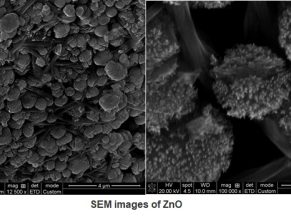
Stage IV – 2017
Pilot experimentation of obtaining technology of some photocatalytic film building materials for technical textiles and architectural coatings.
ICECHIM carried out activities related to the realization, experimentation and verification of the reproducibility of the manufacture technology for photocatalytic composites with type A heterojunctions, based on anatase sensitized with phthalocyanine dyes. Several photocatalysts sensitized with this type of dyes were obtained and embedded in water-based styrene-acrylic paint. The paint was used in photocatalytic tests under visible light irradiation and xenon light. For textile applications hybrid silica film-forming materials containing titania photocatalysts were developed. The
efficiency of the photocatalysts was determined against Methylene Blue, which was used as contaminant. The integrity of the coatings during photocatalytic experiments was determined by FTIR, using SEM and AFM.
Another objective was to evaluate the durability of the coatings designed for textile substrates by measuring lightfastness, fastness to washing and crocking. Lastly, the photocatalytic effect on the integrity of the textile substrate was studied by performing thermo-mechanical analysis on the coated fabrics. Within the project, simple and doped nanostructured oxidic materials based on ZnO and TiO2, were prepared and characterized by ICF. Their photocatalytic properties were verified in photodegradation reactions of some organic compounds such as dyes (Rhodamine B and Methylene Blue) or acids. The method used for the preparation of these materials, namely sol-gel technique, is environmentally friendly, allows a good dopant control and uses a low temperature budget, and have the advantage of being up-scalable. Regarding the effect of photocatalytically
active materials in “architectural coatings” technologies, a complete reaction mechanism was proposed regarding the photocatalytic mineralization of oxalic acid on nanostructured Fe-doped TiO2 powders. The photocatalytic activity of TiO2-Fe materials was correlated with the narrowing of their optical band-gap by Fe doping. Textile materials coated with catalytically-active oxide materials were obtained by the impregnation method. The surfaces of Cotton (BBC) and Polyester (PES) fabrics impregnated with Fe-doped TiO2 oxide powders have been characterized using X-ray Photoelectron Spectroscopy (XPS), Scanning Electron Microscopy (SEM) and UV-VIS spectroscopy. The photo-mineralization reaction of oxalic acid under simulated solar light (A.M.1.5) was studied in the presence of BBC and PES textile samples impregnated with TiO2-Fe powders. Regarding the
oxidation reaction of oxalic acid on impregnated textiles, it was observed that the CO2 formation rate is higher for PES impregnated with TiO2-Fe
compared to BBC.
In good agreement with the activities scheduled in the Project’s Working Plan, the following items were achieved by INCDFM:
a) Synthesis technology, by hydrothermal method, of the following doped TiO2 (anatase) based photocatalytic materials: pure TiO2, and respectively iron, nitrogen, lanthanum, neodymium, europium, praseodymium, samarium, dysprosium and ytterbium doped TiO2;
b) Synthesis technology, by hydrothermal method, with or without surfactant, of the following photocatalytic doped ZnO powders: pure zinc oxide, Fe and nitrogen doped ZnO and Fe, nitrogen and neodymium doped ZnO;
c) Using these technologies, the TiO2 and ZnO doping was achieved in situ, directly in solution, with every mentioned doping element;
d) The hydrothermal conditions used in the frame of these technologies, were optimized in previous stages of this research, with the aim to reduce the hydrothermal process time by increasing the synthesis temperature; e) The TiO2 and ZnO based materials, prepared by means of the proposed technologies in this stage of the project, shown photocatalytic properties in agreement with the project’s objectives, regarding the increase of the photocatalytic properties in UV and visible solar spectrum as well.
INFLPR developed a technological line of laser pyrolysis for the synthesis of photocatalytic composites consisting of anatase and hematite mixed at nanometric scale. The synthesis was conducted using the line for anatase manufacture from titanium tetraisopropoxyde (TTIP), but in this case the precursors were TTIP and iron pentacarbonyl. The partner optimize laser pyrolysis conditions based on the previous achievements obtained in the field of liquid precursor processing and separation and phase transformations in the synthesis zone, spatially determined by the area between the injector and the collector, and which is crossed by the laser beam.
The CHIMCOLOR partner has carried out activities related to the pilot experimentation of the technology of obtaining self-cleaning coating systems for textile substrates and photocatalytic water-based architectural paints. All the products were tested in photocatalytic degradation experiments using simulated indoor and outdoor lighting conditions.
Titania photocatalysts sensitized with organic dyes
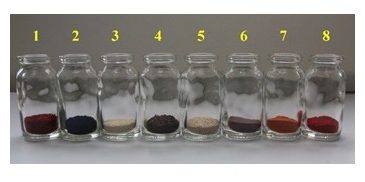
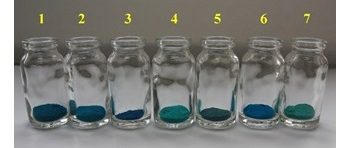
Photodecomposition of Methylene Blue under visible light Photodecomposition of Methylene Blue deposited onto the surface
irradiation using photocatalytic water-based paints of cotton fabrics covered with photocatalytic coatings
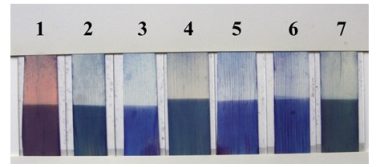
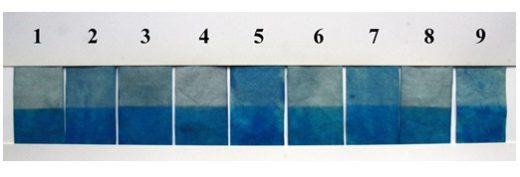
Results
Some original results obtained during the research were the subject of several papers published/to be published or presented as follows:
Papers
- Alina Raditoiu, Viorica Amariutei, Valentin Raditoiu, Marius Ghiurea, Adriana N. Frone, Raluca Augusta Gabor, Luminita Eugenia Wagner, Mihai Anastasescu, „Polyester fibers coated with silica hybrid film forming materials containing non-ionic dyes”, J. Optoelectron. Adv. Mat., 2015, 17(1-2), 198-204
- Alina Raditoiu , Valentin Raditoiu, Daniela Cristina Culita, Adriana Baran, Dan Florin Anghel ,Catalin Ilie Spataru , Viorica Amariutei , Cristian Andi Nicolae, Luminita Eugenia Wagner, “Photophysical properties of some fluorescent materials containing 3-methoxy-7H-benzo[de]anthracen-7-one embedded in sol-gel silica hybrids” Optical Materials, 2015, 45, 55–63
- Traian Popescu, Andreea R. Lupu, Valentin Raditoiu, Violeta Purcar, Valentin S. Teodorescu, “On the photocatalytic reduction of MTT tetrazolium salt on the surface of TiO2 nanoparticles: Formazan production kinetics and mechanism”, J. Coll. Interf. Sci., 2015, 457, 108-120
- Alina Raditoiu, Valentin Raditoiu, Viorica Amariutei, Violeta Purcar, Marius Ghiurea, Monica Raduly, Luminita Wagner, “Surface coating on cellulose fabrics with nonionic dyes – silica hybids”,Mater. Plast., 2015, 4, 442-448
- Irina Stanciu, Luminita Predoana, Crina Anastasescu, Daniela Culita, Silviu Preda, Jeanina Pandele Cusu, Cornel Munteanu, Adriana Rusu, Ioan Balint, Maria Zaharescu, “Structure and properties of vanadium doped TiO2 powders prepared by sol-gel method”,Rev.Roum.Chim.,2014, 59 (11-12),919-929
- Alina Raditoiu, Valentin Raditoiu, Cristian Andi Nicolae, Monica Florentina Raduly, Viorica Amariutei, Luminita Eugenia Wagner, “Optical and structural dynamical behavior of Crystal Violet Lactone – Phenolphthalein binary thermochromic systems”, Dyes Pigments, 2016, 134, 69-76
- Marin Cernea, Valentina Mihalache, Elisabeta Corina Secu, Roxana Trusca, Vasile Bercu, Lucian Diamandescu, “Structural, morphological, ferromagnetic and photoluminescence properties of Fe-doped ZnO, prepared by hydrothermal route”, Superlattices and Microstructures, 2017, 104, 362-373.
- Valentina Mihalache, Marin Cernea, Iuliana Pasuk, “Relationship between ferromagnetism and, structure and morphology in un-doped ZnO and Fe-doped ZnO powders prepared by hydrothermal route” Current Applied Physics, 2017, 17, 1127-1135.
- Irina Stanciu, Luminita Predoana, Jeanina Pandele Cusu, Silviu Preda, Mihai Anastasescu, Katarina Vojisavljevic, Barbara Malic, Maria Zaharescu
“Thermal behaviour of the TiO2-based gels obtained by microwave-assisted sol–gel method” J Therm. Anal. Calorim., 2017, 1-13, DOI :
10.1007/s10973-017-6478-y.
Patent applications
1. Ernest Popovici, “Energy transfer by solid particles in the laser pyrolysis synthesis of nanoparticles” RO 131386 A2
2. Gavrila-Florescu Carmen Lavinia, Ilie Alina Georgiana, Popovici Ernest, Morjan Ion, Scarisoreanu Gina Monica, “Versatile injection system for liquid
precursors in gaseous and /or vapor phase in nanoparticles synthesis by laser pyrolysis” RO 131387 A2
3. Badoi Anca Daniela, Gavrila-Florescu Carmen Lavinia, Popovici Ernest, “Synthesis of nanotubes and / or nanoparticles /nanostructures in direct flux
by laser pyrolysis” RO 131388 A2
4. Scarisoreanu Gina Monica, Gavrila-Florescu Carmen Lavinia, Popovici Ernest, Morjan Ion, “Complex versatile injection of precursors in gaseous / vapor
phase used for obtaining nanoparticles by laser pyrolysis” RO 131389 A2
5. Popovici Ernest, Gavrila-Florescu Carmen Lavinia, Morjan Ion, Ilie Alina Georgiana, “Synthesis of nanopowders by CO2 laser pyrolysis / micrometer
level with or without solid precursor” RO 131436 A2
6. Gavrila-Florescu Carmen Lavinia, Popovici Ernest, Morjan Ion, Lucian Constantin Diamandescu, Raditoiu Valentin, Raditoiu Alina, Wagner Luminita
Eugenia, Bădoi Anca Daniela, Miron Dan “Procedure for obtaining titanium dioxide by laser pyrolysis, for applications in photocatalysis” RO 131631 A2
7. Popovici Ernest, Morjan Ion, Dumitrache Florian, Miron Dan “Synthesis of nano SiC by linear ignited laser pyrolysis” RO 131728 A2
8. Popovici Ernest, Morjan Ion, Dumitrache Florian, Miron Dan, “Synthesis of nano SiC by laser pyrolysis with ignition in volume” RO 131729 A2
9. Mihailescu Ion, Ristoscu Carmen Georgeta, Mihailescu Cristian, Hapenciuc Claudiu, Badiceanu Maria, Gavrila-Florescu Carmen-Lavinia, Popovici
Ernest “Flexible laser deposition system” RO Patent application A/00123/1.03.2017
10. Popovici Ernest, Gavrila-Florescu Carmen-Lavinia, Dutu Elena “ Equipment for the synthesis of photocatalytic composites with heterojunctions by
laser pyrolysis” RO Patent application A/00667/18.09.2017
11. Raditoiu Valentin, Amariutei Viorica, Raditoiu Alina, Raduly Florentina Monica, Wagner Luminita Eugenia “ Process for the functionalization of natural
and synthetic textile fibers with photocatalytic film-forming materials “ RO Patent application A/00750 /27.09.2017
12. Raditoiu Valentin, Amariutei Viorica, Raditoiu Alina, Raduly Florentina Monica, Wagner Luminita Eugenia Parsu Dumitru, Parsu Lenuta, Parsu Mihai “
Photocatalytic water-based film-forming compositions and process for their obtaining” RO Patent application A/00751/27.09.2017
Scientific events
1. Augusta Raluca Gabor, Cristian Andi Nicolae, Valentin Raditoiu, Viorica Amariuţei, Alina Raditoiu, Luminita Wagner – Thermo-mechanical behavior of polystyrene and polypropylene – TiO2 composite films upon ageing – International Symposium PRIOCHEM “Priorities of chemistry for a sustainable development”, 10-th edition, 30-31-st October 2014, Bucharest, Romania
2. Augusta Raluca Gabor, Cristi Andi Nicolae, Alina Raditoiu, Viorica Amariutei, Monica Mihailescu, Valentin Raditoiu – Photo-induced degradation of polystyrene-TiO2 composite films – structural and surface changes and their influence on thermo-mechanical properties – The 4-th International Colloquium « Physics of Materials » november 13-14-th, 2014, University Politehnica of Bucharest, Romania
3. L. Predoana, I. Stanciu, J. Pandele, S. Preda, C. Anastasescu, B. Malic, M. Zaharescu – Thermal stability of the V-doped TiO2 gels obtained by microwave assisted sol-gel method- 3rd Central and Eastern European Conference on Thermal Analysis and Calorimetry, August 25-28-th, 2015, Ljubljana, Slovenia
4. M. Zaharescu, I. Stanciu, L. Predoana, C. Anastasescu, D.C. Culita, S. Preda, J. Pandele Cusu, C. Munteanu, A. Rusu, I. Balint –V-doped TiO2 sol-gel nanopowders with catalytic properties – (poster)- XVIII International Sol-Gel Conference (Sol-Gel 2015) September 6 – 12-th, 2015, Kyoto, Japonia
5. M. Anastasescu, I. Stanciu, L. Predoana, C. Anastasescu, D.C. Culita, S. Preda, J. Pandele Cusu, C. Munteanu, A. Rusu, I. Balint, M. Zaharescu – Multifunctional V-doped TiO2 materials for organic compounds degradation – 7th International Workshop “Advanced optical and X-ray characterization techniques of multifunctional materials for information and communication technologies, health and renewable energy applications”, September 16-18-th, 2015, Bucharest, Romania
6. L. Predoana, I. Stanciu, J. Pandele, S. Preda, C. Anastasescu, M. Zaharescu – Thermal stability of oxide nanopowders based on TiO2 obtained by sol-gel
method in microwave field – 12-th National Symposium on Ceramics 20-th November 2015, Bucharest, Romania
7. L. Predoana, I. Stanciu, J. Pandele, S. Preda, A. Rusu, C. Anastasescu, M. Patrascu, M. Zaharescu,’’V-doped TiO2 nanopowders obtained by microwave assisted sol-gel method’’ – 3rd Global Congres on Microwave Energy Aplications, 3G CMEA, 25-29 July 2016, Cartagena, Spain
8. L. Predoana, I. Stanciu, M. Anastasescu, J.M. Calderon Moreno, M. Stoica, S. Preda, M. Gartner, M. Zaharescu, “Influence of the microwaves on the TiO2 based sol-gel processes and on the properties of the resulted nanostructures’’ – 16th International Conference of Physical Chemistry – ROMPHYSCHEM16, 21 – 24 September, 2016, Galati, Romania
9. M. Stoica, S. Mihaiu, O. Mocioiu, M. Anastasescu, J.M. Calderon-Moreno, L. Predoana, I. Atkinson, S. Preda, C. Anastasescu, I. Balint, M. Zaharescu, “Synthesis, structural properties and photocatalytic behavior of ZnO powders prepared by sol-gel method’’ – 16th International Conference of Physical Chemistry – ROMPHYSCHEM16, 21 – 24 September, 2016, Galati, Romania
10. M. Anastasescu, L. Predoana, E. Craciun, J. Pandele Cusu, I. Atkinson, A. Rusu, S. Preda, E. M. Anghel, A. Ioancea, C. Anastasescu, M. Stoica, V. Bratan, I. Balint, M. Zaharescu, “Doped TiO2 gels and powders: preparation, physico-chemical properties and solar-light photocatalytic activity’’ – 16th International Conference of Physical Chemistry -ROMPHYSCHEM 16, 21 – 24 September, 2016, Galati, Romania
11. L. Predoana, I. Stanciu, J. Pandele, S. Preda, C. Anastasescu, B. Malic, M. Zaharescu “Thermal stability of the V-doped TiO2 microwaves assisted sol-gel methods’’ – The 25th Symposium on Thermal Analysis and Calorimetry – Eugen Segal, Bucharest, 15-th of April 2016
12. M. Zaharescu, “Influence of the microwaves on the TiO2 based sol-gel processes and on the properties of the resulted nanostructures’’- The 9-th Edition of Symposium with international participation – New trends and strategies in the chemistry of advanced materials with relevance in biological systems, technique and environmental protection, June, 9-10, 2016, Timisoara
13. L. Gavrila-Florescu, E. Popovici, I. Morjan, E. Dutu, A. D. Badoi, G. Demian, M. Demian, M. Iliescu, E. M. Stanciu, L. C. Diamandescu, V. Raditoiu, A. Raditoiu, L. E. Wagner, “Method of nano titanium dioxide synthesis by laser pyrolysis targeting photocatalytic applications”, ICPEPA-10 10th International
Conference on Photoexcited Processes and Applications, August 29 – September 2, 2016, Brasov, Romania
14. Roxana Trusca (University Politehnica of Bucharest), Lucian Diamandescu, Vasile Adrian Surdu „Structural and morphological evolution with temperature of zinc oxide doped with iron and neodymium”. (Poster S6–326). 20thRomanian International Conference on Chemistry and Chemical Engineering (RICCCE 2017) 6 – 9 September 2017, Poiana Brasov, Romania.
Contact
National Research and Development Institute for Chemistry and Petrochemistry – ICECHIM Bucharest,
202 Spl. Independentei, sector 6, OP-CP 35-174, 060021, Bucharest
Project Manager: Valentin Raditoiu
Tel. +4021 316.30.62/118
Fax: +4021 312.34.93
E-mail:
Web: www.icechim.ro
